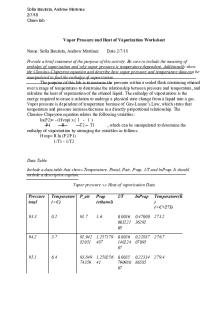Vapor Pressure and Heat of Vaporization Lab PDF

| Title | Vapor Pressure and Heat of Vaporization Lab |
|---|---|
| Author | Mariah Kador |
| Course | Gen Chemistry Lab |
| Institution | Northwestern State University of Louisiana |
| Pages | 3 |
| File Size | 59 KB |
| File Type | |
| Total Downloads | 96 |
| Total Views | 155 |
Summary
Chemistry Lab Report...
Description
Vapor Pressure and the Heat of Vaporization Experiment #2
OBJECTIVES This experiment aims to research the relation between a liquid-vapor pressure and its temperature by utilizing the Clausius Clapeyron equation to calculate the heat vaporization of the unknown substance and the information obtained in this experiment.
INTRODUCTION Liquids are made up of different molecules of film energies. There is film energy to escape to the gas phase of some faster liquid molecules. Some of the slowest steam molecules condense in the fluid at the same time. The vaporization rate of a bottle is greater than that of the condensation, which eventually evaporates the solvent. The relation between the vapor pressure and the temperature of the solution is discussed in this experiment. The gas pressure sensor and the temperature sensor gather pressure and temperature data. The atmospheric pressure is extracted from the total pressure by vapor pressures.
PROCEDURE Start by filling a 600 mL tap water beaker and start to heat on a hot plate. Then, get a temperature and gas tension sensor and insert a 125 mL flask with the rubber stopper. Next, in the 1000 ml water beaker, position the temperature sample. , Then keep the flask in the water, the temperature should be room temperature. Finally, open the two-way valve by pressing the syringe plunger and inject the liquid into the pitcher and repeat at 40-45°C and 50-55°C.
EXPERIMENTAL RESULTS
TRIAL
1
2
3
4
TEMPERATURE (C)
17.6 C
32.6 C
41.6 C
50 C
TEMPERATURE (K)
290.65 K
305.75 K
314.75 K
323.15 K
104.30 kPa
101.10 kPa
101.17 kPa
MEASURED TOTAL 101.35 kPa PRESSURE (kPa)
For propanol, the equation of the equation was y = -25040x + 84.64. The function ∆HVapR is equal to -25040 and R = 8.31 J/mol•K. Therefore, ∆HVapR=-25040 ∆HVap=-25040*8.31J/mol. K ∆HVap=-208.08KJ/mol
CONCLUSION The heat of propanol vaporization was detected in the experiment. The increase in temperature allows for an increase in air pressure and steady maintenance in volume. The vapor pressure above the solvent is raised by a higher solvent temperature. Unfortunately, the vapor pressure has not improved due to an experimental error with a hole in the center of the stopper. This was clearly seen in the diagrams of the vapor pressure. The accepted values and compounds of the, as well as the calculated values, were substantially different. These failures during the experiment can be attributed.
POST LAB QUESTIONS 1. What is the purpose of the lab? This experiment aims to research the relation between a liquid-vapor pressure and its temperature by utilizing the Clausius Clapeyron equation to calculate the heat vaporization 2. What are the Science concepts of this lab? Briefly Explain the science/chemistry concepts(s) involved in this lab. This experiment involves
1
3. What is your hypothesis about the outcome of this lab? If the temperature increases, then the pressure will increase. 4. What results were obtained? (values) Temperature and measured total pressure were measured. 5. How do these results address the purpose of the lab? This requires looking at the experimental titles, the purpose, the data, and calculation sections of the lab notebook and bringing them all together. What do the results mean? The results revealed that the increase in temperature allows for an increase in air pressure and steady maintenance in volume. 6. What errors could have happened or how could this lab activity be improved to address the purpose? The hole in the stopper prevented the pressure from increasing as the temperature increased.
2...
Similar Free PDFs

Vapor Pressure lab final
- 11 Pages

ANTOINE COEFFICIENTS FOR VAPOR PRESSURE
- 212 Pages

centre of pressure Lab report
- 10 Pages

Specific Heat of Lead Lab
- 2 Pages

Enthalpy of vaporization
- 6 Pages

Blood Pressure Lab Report
- 10 Pages
Popular Institutions
- Tinajero National High School - Annex
- Politeknik Caltex Riau
- Yokohama City University
- SGT University
- University of Al-Qadisiyah
- Divine Word College of Vigan
- Techniek College Rotterdam
- Universidade de Santiago
- Universiti Teknologi MARA Cawangan Johor Kampus Pasir Gudang
- Poltekkes Kemenkes Yogyakarta
- Baguio City National High School
- Colegio san marcos
- preparatoria uno
- Centro de Bachillerato Tecnológico Industrial y de Servicios No. 107
- Dalian Maritime University
- Quang Trung Secondary School
- Colegio Tecnológico en Informática
- Corporación Regional de Educación Superior
- Grupo CEDVA
- Dar Al Uloom University
- Centro de Estudios Preuniversitarios de la Universidad Nacional de Ingeniería
- 上智大学
- Aakash International School, Nuna Majara
- San Felipe Neri Catholic School
- Kang Chiao International School - New Taipei City
- Misamis Occidental National High School
- Institución Educativa Escuela Normal Juan Ladrilleros
- Kolehiyo ng Pantukan
- Batanes State College
- Instituto Continental
- Sekolah Menengah Kejuruan Kesehatan Kaltara (Tarakan)
- Colegio de La Inmaculada Concepcion - Cebu









